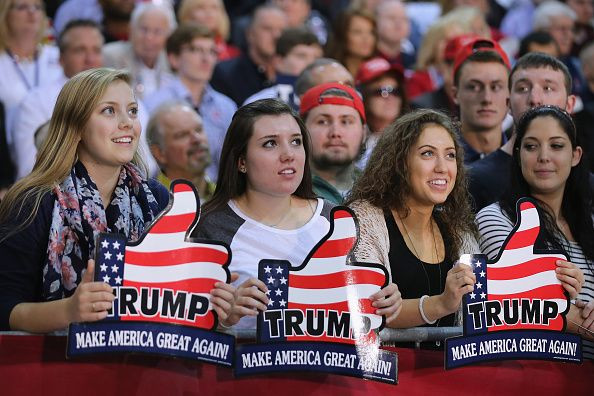GOP Falling Short In Bid To Diversify Support

Ten months before the United States elects a new president, the Republican Party has yet to resolve a problem that its leaders said contributed to Mitt Romney’s 2012 loss to Barack Obama: a lack of support among Hispanic and younger voters.
The percentage of Republicans among those likely to vote in the Nov. 8, 2016, election lags Democrats by 9 percentage points, compared with a 6-point deficit in the year leading up to Obama’s 2012 victory, according to an analysis of Reuters/Ipsos polling data from 2012 and 2015.
While the American electorate has become more diverse the last three years, the party’s support among Hispanic likely voters and younger likely voters has shrunk significantly.
Polling data on likely voters who identify as members of a particular political party are considered valuable indicators of election outcomes. In 2012, 93 percent of voters who identified as members of a particular party cast a ballot for that party’s presidential candidate, a Reuters/Ipsos Election Day poll found.
The numbers suggest the Republican field, led by billionaire businessman Donald Trump, faces strong headwinds against the Democrats, led by former secretary of state Hillary Clinton.
"Good candidates running good campaigns can overcome partisan disadvantages,” Republican pollster and strategist Neil Newhouse said. “The party faced these same challenges in 2012 and is still facing those challenges, and it is potentially more significant.”
An analysis of the Reuters/Ipsos polling data found:
- In 2012, Democrats made up 44.7 percent of party-affiliated likely voters, compared to 39.1 percent Republicans, a difference of about 6 percentage points, according to the analysis of 87,778 likely presidential voters polled leading up to the 2012 presidential election. The results have a credibility interval of plus or minus 0.3 percentage points.
- Three years later, that lead had grown to nine points, 45.9 percent to 36.9 percent, according to the analysis of 93,181 likely presidential voters polled in 2015. The results in 2015 have the same credibility interval as 2012.
- Among Hispanics who are likely presidential voters, the percentage affiliated with the Republican Party has slipped nearly five points, from 30.6 percent in 2012 to 26 percent in 2015. Meanwhile, Hispanic Democrats grew by six percentage points to 59.6 percent.
- Among whites under 40, the shift is even more dramatic. In 2012, they were more likely to identify with the Republican Party by about 5 percentage points. In 2015, the advantage flipped: Young whites are now more likely to identify with the Democratic Party by about 8 percentage points.
- Meanwhile, black likely voters remain overwhelmingly Democratic, at about 80 percent.
BREAD AND BUTTER VOTERS
For both parties, the election will partly hinge, as always, on getting out the votes, Newhouse said. But for a Republican to win, the gap in party membership means their voters need to show up at a much higher rate than Democratic voters.
In November 2014, Republican voters did just that with dramatic congressional victories that allowed the GOP to take control of the U.S. Senate and solidify its control of the U.S. House of Representatives. Those gains, during a low-turnout midterm election, were fueled by turnout among older white voters.
Ari Fleischer was co-author of “Growth and Opportunity Project,” the Republican postmortem of Romney’s 2012 loss which concluded that the party had to connect with minorities, especially Asians and Hispanics, and the young.
“If our Party is not welcoming and inclusive, young people and increasingly other voters will continue to tune us out,” the authors wrote.
A former press secretary to President George W. Bush, Fleischer said Republicans' "bread and butter" support comes from a powerful and growing block of voters: whites over 55. The numbers bear that out.
Aging baby boomers likely to vote in a presidential election remain strongly Republican, up slightly to 47.7 percent of voters polled in 2015. The share of that group who identify as Democrats slipped nearly two points to 35.4 percent in 2015.
DIVERSE FIELD
An irony is that the Republican presidential field is younger and more diverse than the Democratic contenders. It includes Hispanics Ted Cruz and Marco Rubio, both in their mid-40s; two business people - Trump and a woman, Carly Fiorina; and a retired neurosurgeon, Ben Carson, who is black.
All three Democratic candidates are white and long-time politicians, though Clinton, the front-runner, is a woman.
Republican Senator Dean Heller of Nevada said the rhetoric coming from some of his party’s candidates is dampening any hope their message will resonate beyond the party’s base.
Heller, who has endorsed former Florida Governor Jeb Bush for the Republican nomination, noted Bush's brother George W. Bush got about 40 percent of the Hispanic vote in 2004 while Romney got just 28 percent in 2012.
“So it is possible for a Republican candidate to do well with the Hispanic community,” Heller said. “And we have to do better or we’re not going to win this presidential race.”
Carlos Firpi is a 31-year-old Hispanic voter and a Republican. Earlier this year, he considered himself a Trump supporter. No longer.
“Now I don’t know who to support,” said the computer technician from Carlisle, Pennsylvania. “Unfortunately, all I seem to hear anymore from anyone in the Republican Party is extremism.“
Firpi said he is naturally drawn to the party’s emphasis on self-reliance and a limited role for government. And he remains a Republican but also understands why Hispanics and young voters would feel alienated. “It concerns me, too.”
Former Republican National Committee Chairman Michael Steele said the party needs to reach out to minority groups between campaign cycles.
“It’s not something you get done in one cycle; it’s not something you get done in two cycles. It’s something that’s done over time,” he said after watching December's Republican debate in Las Vegas.
(Editing by Howard Goller)
© Copyright Thomson Reuters {{Year}}. All rights reserved.





















